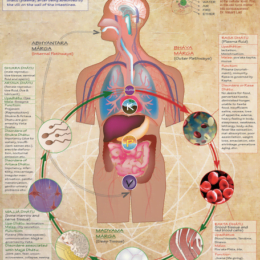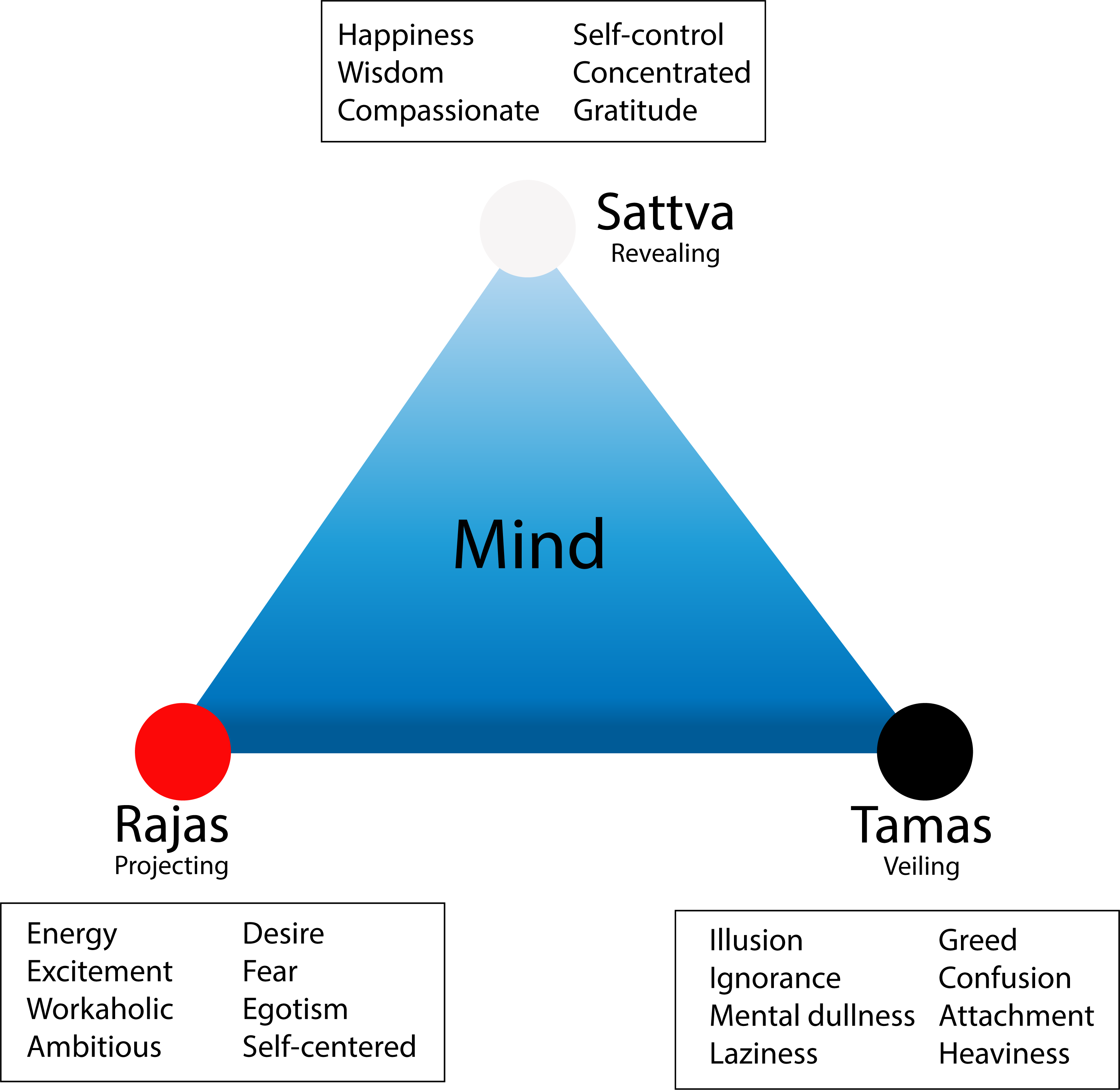
In Ayurveda the most common term used to denote disease is roga. The term roga is derived from the root ‘ruk’ meaning pain. Even the diseases that do not produce physical pain inflict some mental agony in the person. Hence the name ROGA is meaningful. The disease is caused by deranged doshas. Hence it is usually considered as a derangement of doshas. But doshas alone cannot manifest as diseases. They pollute tissues (dhātu) and wastes (mala) and produce the disease. This interaction between humors (dosha) and tissues and wastes (dūṣya) is termed Dosha Dūṣya Sammūrchana. Usually, an abnormal increase of doshas initiates the pathologic process.
Decrease of doshas generates diseases passively by lack of function and by relative increase of other doshas. When a dosha is increased or decreased, the other doshas are also affected. A decrease of any dosha causes the relative increase of other doshas. Similarly, an increase of a dosha causes the relative reduction of other doshas. Doshas are increased by the use of similar substances, i.e., substances and actions having the same properties. Thus, exposure to wind increases vāta. Dry food increases vāta. Cold climate increases vāta.
Excessive physical exercise increases vāta. Contact or use of dissimilar substances decreases doshas, i.e., substances which have the opposite properties of a dosha tend to nullify the dosha and result in the reduction in its quality and quantity. For example, hot substances decrease vāta. Unctuous substances also decrease vāta. Rest, lack of exercise decreases vāta. The theory of ‘increase by generality’ (Sāmānya vṛddhi siddhānta) states that – “like increases like”. It also implies that “opposites decrease”. Similarity
and dissimilarity may be in material (dravya), property (guṇa), or action (karma). Dairy is similar in material to breast milk. Cold water is similar in property to vāta though it is a different material. Avoiding sleep is like vāta because it causes drying.
The three kinds of Diseases
This classification is more in concordance with the philosophical point of view. Earlier in this topic, it was mentioned that every disease represented some sort of pain. Now the origin of this pain can be due to three causes.
- Ādhyātmika – The cause of diseases of this kind is the self. I.e. the mind and body of the sufferer. The doṣas of body and mind are considered in assessing this group. The disease process is initiated with an imbalance of the doṣas which then takes various roads of pathophysiology.
- Ādhibhautika – These types of diseases are caused by external agents like trauma, poisons, infections, etc. An external factor causes a dhātu vitiation which then leads to doṣic imbalance.
- Ādhidaivika – These include those types of diseases of which the specific etiology is subtle or not directly perceived. It is also associated with genetic and hereditary factors. Sometimes a divine hand is believed to be involved in diseases under this classification. Diseases caused due to sudden and slow changes in nature or its elements are also classified in this category.
Classification of Vyādhi
There are various classifications for diseases according to different criteria. The various classifications of diseases are not mere academic exercises. These classifications place the disease to be treated in various perspectives and hence decide the course of treatment. For instance, take the case of a headache. It may be physical (as in sinusitis) or mental (e.g., tension headache). It may be due to the primary vitiation of humors (doṣa) or could be due to trauma. It may be medical in most cases but could be surgical as in the headache due to a brain tumor. Hence, the classification of diseases has importance from the treatment
point of view.
3 Fold Classification
- Doṣaja – Due to tridosha imbalance
- Karmaja – Transcending effects of past births
- Doṣakarmaja – Combined effect of the above two
4 Fold Classification
- Āgantu – Diseases occurring due to exogenous causes.
- Śarīra – Diseases occurring due to endogenous causes.
- Mānasa- Diseases of the mind
- Svābhāvika- Diseases that are occurring as part of the normal advancement of life and surroundings
7 Fold Classification
1. Hereditary or Inherited
Vāgbhaṭa: Sahaja
Suśruta: Ādibalapravṛtta
Description: Are inherited from the mother or father through genes. Hence, they may be maternal or paternal in origin.
Diseases: Hereditary: Maternal and paternal (due to abnormalities of Śukra and ārthava)
Examples: Kuṣṭha, Arśa, Meha, Maturity onset diabetes mellitus, piles, etc.
2. Congenital
Vāgbhaṭa: Garbhaja
Suśruta: Janmabalapravṛtta
Description: Are those generated due to the etiological factors occurring during the intra-uterine life. This may be due to the unwholesome practices of the mother during pregnancy or due to diseases suffered by the mother during pregnancy. Diseases due to labor, birth trauma are also usually included under this.
Why: imbalances happened during pregnancy
Examples: Handicap (hunch back, lameness, etc) leukoderma
3. Endogenous or Acquired
Vāgbhaṭa: Jātaja
Suśruta: Doṣabalapravṛtta
Description: Are diseases occurring after birth due to the vitiation of the humors (doṣas). These are generated independently by the unwholesome practices of the person or as a complication of existing diseases. They may be classified into two: physical and mental. Endogenous diseases are also classified as occurring in āmāśaya and occurring in pakvāśaya. Another classification is according to etiology is that caused by reduction (apatarpaṇaja) and caused by addition (santarpaṇaja). The above three types of diseases involve the vitiation of doṣas at different phases. Hence, they come under personal diseases.
Why: Various metabolic and psychological diseases caused by one’s own improper food
Examples: Diseases due to over-nourishment or under-nourishment or Ahitāhāra.
4. Traumatic
Vāgbhaṭa: Pīḍhāja
Suśruta: Saṃghātabalapravṛtta
Description: Physical and Mental trauma. Are those occurring to one by collision with stronger substances. They are subdivided into two viz. animate (vyālādikṛtā) and inanimate (śastrakṛtā).
● Trauma caused by animate things (e.g., A charging bull) is animate.
● Trauma caused by inanimate things such as stones, knives, and bullets is inanimate.
● Traumatic diseases may be also divided according to the substrate of disease viz.
Mental (manasika) and physical (śārīra).
Diseases: –
Examples: Wounds, fractures, anger, grief, fear
5. Seasonal or daily variations
Vāgbhaṭa: Kālaja
Suśruta: Kālabalapravṛtta
Description: Caused by cold/ heat or due to abnormal nature of seasons or by not following Ṛtucaryā.
They are of two types:
● Due to an improper season.
● Due to lack of protection.
An improper season is that which does not have the original features, features in excess, or strange features.
Diseases: –
Examples: –
6. Providential/Influential
Vāgbhaṭa: Prabhāvaja
Suśruta: Daivabalapravṛtta
Description: Caused by the curse of God or Godly men, violation of tradition or possession by Piśāca (goblins).
those occurring due to striking thunderbolt/lightning etc. Ancient people believed that such accidents are due to the curse of God. Hence the name is providential.
They are divided into two viz. due to natural calamities and due to demons. Thunderbolts, acid rains, floods, etc. are natural phenomena. Demonic disorders are in fact of mental origin, such as possession syndrome (intangible mental disorders that portray a possessed state). Providential diseases may be also divided into contagious (saṃsargaja) and accidental
(ākasmika). It was believed that possession syndromes etc. occur due to contact with evil spirits. Hence, they were contagious. Infectious diseases that spread also are included in this group. Diseases occurring from accidents such as a strike of a thunderbolt are accidental. These diseases can also be divided into mental and physical.
Diseases: –
Examples: Lightening strike, possession
7. Natural
Vāgbhaṭa: Svabhāvaja
Suśruta: Svabhāvabalapravṛtta
Description: are diseases occurring naturally due to the life process such as thirst, hunger, wrinkles, graying of hair, etc. They may be divided into timely and untimely. Early graying is untimely but graying at the age of forty years may be timely. Natural diseases may occur due to lack of protection and despite the protection. Wrinkling of skin in old age, despite regular skincare, is an example of natural disease despite the protection. Early wrinkling due to a lack of skincare is an example of disease due to a lack of protection.
Diseases: –
Examples: Hunger, thirst, senility, etc. (either timely or pre-mature)
Vyādhi Hetu – Causes Of Disease
1. Naiṣṭhikī vyādhi hetu
Absolute cause. This concept is very much juxtaposed to the Buddhist philosophy that all pain has its root cause in desire. Caraka explains that upadhā or desire generates bhogatṛṣṇā, the craving for pleasure and it then leads to various materialistic factors culminating in disease.
2. Laukika vyādhi hetu
a. Dhī-dhṛti-smṛti vibhraṃśa – Derangement of intellect, cognition or memory.
b. Kāla viparyaya – Forces of nature that causes alterations in the balanced doṣa state.
c. Asātmyendriyārtha samyoga – Faulty reception, perception or analysis of senses.





